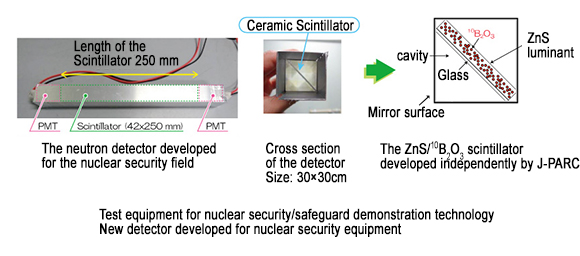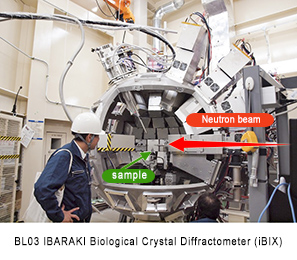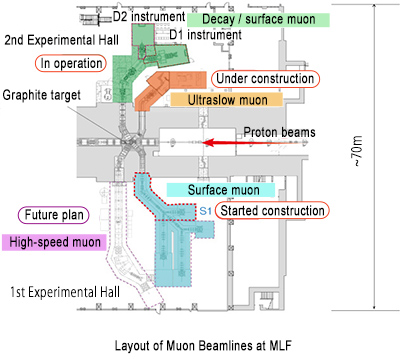| ¡@J-PARC News - April 2013 (Issue #97) |
| Neutron detectors using helium-3 gas (3He) are widely used at J-PARC and throughout the world in pulsed neutron source facilities, and in the field of nuclear security. However, in recent years, there has been a severe shortage in the supply of 3He gas, and thus there is an urgent need to develop a substitute detector.
At J-PARC, we have been developing a two-dimensional detector using wavelength shifting fiber together with a scintillator based on a new material (ZnS/10B2O3) for detection of high-intensity neutrons. We have also been developing measurement technology for this system. The detector has already been installed, and is in use, in the Materials and Life Science Experimental Facility (MLF) beamlines such as BL03 (Ibaraki Biological Crystal Diffractometer : iBIX) and BL18 (Extreme Environment Single Crystal Neutron Diffractometer : SENJU) . We are applying this unique technology to meet the urgent need for an alternative to 3He detectors. We expect to achieve practical use, and are currently conducting further R&D with international cooperation.
Recently, we completed a detector employing this J-PARC technology (Fig. 1, 2) , as the detector in non-destructive measurement equipment for safeguard demonstration testing. The purpose of the detector is to measure neutrons from substances such as U and Pu contained in nuclear fuel. The plan calls for 60 or more of these detectors to be installed in equipment designed by the Nuclear Science and Engineering Directorate of the JAEA, and neutron measurement should proceed with high detection efficiency. In this way, neutron measurement technology previously developed by J-PARC is being applied to neutron measurement in the nuclear security field. |
  |
 * Click here to enlarge. * Click here to enlarge. |
|
| Elucidation of the Hydrogen Activation Mechanism of Nickel-Iron Catalyst using the "iBIX" Neutron Experimental Equipment |
| The hydrogen activity mechanism of a newly developed Ni-Fe catalyst has been elucidated in neutron-based experiments using the BL03 Ibaraki Biological Crystal Diffractometer (iBIX) of MLF. The ability to use inexpensive iron as a catalyst for promoting (inhibiting) chemical reactions is a revolutionary result that will open the way to future applications in areas such as fuel cell catalysts. The result was made possible by the superior performance of the iBIX, equipped with scintillators made from a new material. This research achievement was published in the digital version of the American science journal, "Science" (Feb. 8, 2013) . The joint research was conducted with Kyushu University, CROSS and Ibaraki University.
For details : CROSS HP (http://www.cross-tokai.jp/ja/news/2013/v13001/) |
 |
 * Click here to enlarge. * Click here to enlarge. |
| £to Page Top |
|
| Special Report : MLF Slow Muon Beamline |
| In the muon experimental area of the MLF's First Experimental Hall, construction has begun on a slow muon beamline (S-line) whose purpose is utilization focused on the positive muons that are the most frequently used in materials development research. This line will make research using muon beams more broad-based, and researchers have proposed installation of the following four types of experimental equipment using the μSR method (muon spin rotation, relaxation or resonance) , in order to achieve higher level performance: experimental equipment with an ultra-low temperature environment (S1 line) , experimental equipment with a pulsed extreme environment (S2 line) , experimental equipment enabling measurement at high time resolution (S3 line) , and experimental equipment using a photoelectric element semiconductor (μPMT : next-generation photomultiplier tube) instead of a photomultiplier tube (S4 line) .
∗ μSR method: Method for measuring micro magnetic fields in a sample by detecting the positrons emitted when muons decay inside the sample. Detection is achieved by using multiple scintillators and photomultiplier tubes (PMT) placed before and after the sample.
∗ Photomultiplier tube: An optical sensor enabling detection even of ultra-faint light. Ordinary products are small cylindrical vacuum tubes with a diameter of 1.5 cm and length of 5 cm. |
  |
 * Click here to enlarge. * Click here to enlarge. |
| £to Page Top |
|
| Single bunch operation testing |
| In the pulsed neutron source of MLF, a pulsed proton beam (pulse width approx. 0.6μsec) is received at 25 Hz from the 3 GeV synchrotron (RCS) , and the pulsed neutron beam produced by the nuclear spallation reaction is used for neutron experiments. In an ordinary RCS, protons are accelerated in a double bunch (2 bunches) . Protons in the double bunch are simultaneously extracted with an extraction kicker magnet, and that is taken to be a single pulse. Therefore, neutron beams produced by the neutron source have source characteristics attributable to the double bunch, and in some cases this increases the uncertainty in data analysis. Therefore, there are some experiments using neutrons where researchers want to employ single bunch operation. Recently a data set on characteristics was obtained by conducting experiments using neutrons via single bunch operation, with the Accurate Neutron-Nucleus Reaction Measurement Instrument (BL04 : ANNRI) and the Neutron Beam-line for Observation & Research (BL10 : NOBORU) . It should be possible to improve the precision of analysis results using this data. |
|
| Operation Status of J-PARC in Fiscal 2012 |
| J-PARC accelerator operation time in the fiscal year of 2012 from April 2012 to March 2013 was a total of 6,328 hours. In operation using each experimental facility, availability was satisfactory at 93% for the Materials and Life Science Experimental Facility, and 88-89% for both the Hadron and Neutrino Experimental Facilities. Previously, most of the factors causing stoppages in beams from the accelerator to experimental facilities were due to the RFQ (Radio Frequency Quadrupole Linac) at the initial stage of the linac. However, since April 2012, RFQ has been greater than other factors in terms of the number of accelerator beam stoppages, but it was possible to reset the systems in a short time, and thus the stopping time itself was about half that of the DC high-voltage power supply of the linac (which had the longest time) . This indicates that RFQ operation is stable. |
|
| Facility updates |
| At the linac, independent testing of each system - including the ion source, high-voltage power supply, and RFQ - is being conducted on the test stand for RFQ. In addition, preparation work is underway for 600 kW high-power testing of the ACS (Annular Coupled Structure Linac) to be installed at the stage after the accelerator during the long shutdown period from August to December this year.
Proton beam single bunch operation to the MLF was performed from March 27 to April 1 at the 3 GeV synchrotron (RCS) . At the 50 GeV synchrotron (MR) , there was trouble in the middle of March with the low-field septum magnet used to extract the proton beam to the Hadron Experimental Facility. The septum coil that caused the problem was fabricated anew, and replacement/adjustment work was performed with an eye on resuming operation using hadrons on April 27. The coil was reinstalled in the beam line on the 22nd.
Construction of an ultra-slow muon beamline (U line) is progressing at the MLF. On March 22, we carried in a laser system for generating ultra-slow muons, and installation/adjustment work is being conducted. Various tasks were conducted at the Hadron Experimental Facility, including equipment adjustment in each beamline, and construction of the K1.1 beamline. At the Neutrino Experimental Facility, data was steadily accumulated at a beam intensity of approx. 220 kW. In the target station building, tests were conducted, together with joint researchers from overseas involved in the T2K Neutrino Experiment, for installation of the graphite target spare in the spare for the 1st electromagnet horn. |
|
| Dr. Atsushi Kimura Receives AESJ (Atomic Energy Society of Japan) Best Paper Award (3/26) |
| Spent nuclear fuel produced in the operation of nuclear reactors contains radionuclides (MA : Minor Actinoids) and long lived fission products (LLFP) which emit radiation over long periods of a few tens of thousand to a few hundred thousand years. One possibility for reducing environmental impact in geological disposal is to separate out these substances, and shorten their life by irradiating them with neutrons. However, to evaluate the effectiveness of this approach beforehand, it is necessary to precisely measure the neutron capture cross section of these nuclides (numeric value indicating the degree of reaction, units: barn) .
The Accurate Neutron-Nucleus Reaction measurement Instrument (ANNRI) installed in BL04 of MLF at J-PARC is an experimental instrument designed to enable measurement of the capture cross section at high precision, using a high-intensity pulsed neutron source and a high-performance gamma ray detector. Recently, Dr. Kimura et al. used ANNRI to demonstrate that the neutron capture cross section of 244Cm, a type of MA which has been difficult to measure, can be measured at high precision in the energy range of 2-300 eV. Receipt of this award was based on Dr. Kimura's result showing the effectiveness of capture cross section measurement for samples whose radioactivity will be high in the future.
sAward recipientst Dr. Atsushi Kimura of Nuclear Science and Engineering Directorate (NSED) of Japan Atomic Energy Agency (JAEA) and MLF of J-PARC, Dr. Shinji Goko of Japan Nuclear Energy Safety Organization (JNES) , and Assistant Prof. Toshiyuki Fujii of Kyoto University Research Reactor Institute Title FuNeutron-capture cross-sections of 244Cm and 246Cm measured with an array of large germanium detectors in the ANNRI at J-PARC/MLFv |
|
|
|
Copyright 2011 JAEA and KEK Joint Project. All rights reserved.
|
|